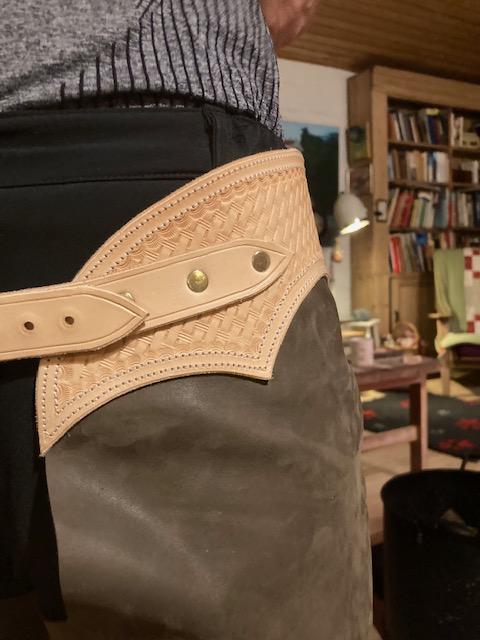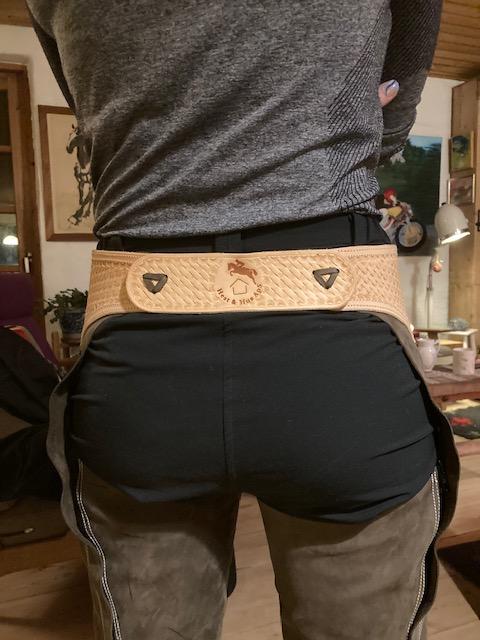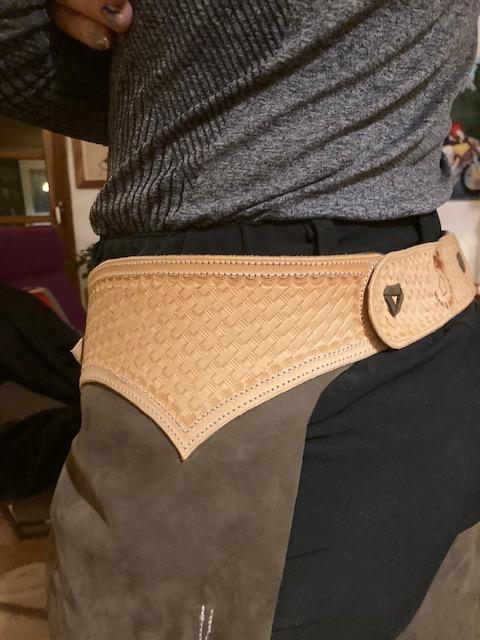-
Posts
759 -
Joined
-
Last visited
Content Type
Profiles
Forums
Events
Blogs
Gallery
Everything posted by Mulesaw
-
Shotgun chaps with tooled yokes
Mulesaw replied to Mulesaw's topic in Clothing, Jackets, Vests and Chaps
@TomE Thanks for the nice words :-) I think the logo is pretty good looking as well, especially on this light veg tan. The sewing was all done on my old patcher, but it did an admirable job I think. Brgds Jonas -
At first I thought it looked a bit overwhelming with the stained basket weave, but after the painting of the flag and the pole it looks good to me. My only suggestion would be to move the face of the bearer a smidge forward (if that is possible), or move the hat a little down on the head instead. On the line drawing, it is easy to see that the bearer is wearing a cap, and you can see the contours of his face, but on your practice piece, it looks kind of like he isn't wearing a hat, other than a strange pointy shade over his eyes. It is a minor detail, but I think it will be worth it. Also on the line drawing there is a resolute stout expression on the bearer, aided by a strong chin and a good posture. It might just be the chest of the bearer that has fallen a bit on the carving, but that gives a different look. I am looking forward to seeing the finished case Brgds Jonas (who is no where near being able to carve something like this)
-
Shotgun chaps with tooled yokes
Mulesaw replied to Mulesaw's topic in Clothing, Jackets, Vests and Chaps
hmmm, now you got me confused :-) If there is only hair on the front, then is the back of the goat skin "shaved" or is the back of the batwings just the canvas? I have never seen a pair, so I have absolutely no idea, and when I googled images of woolies, all the pictures showed them from the front. -
Shotgun chaps with tooled yokes
Mulesaw replied to Mulesaw's topic in Clothing, Jackets, Vests and Chaps
It is funny how we can remember specific things like clothing, even so many years after. I can still remember some of the jackets I wore as a kid, I don't know why that is. I know my wife commented on it at some time that she felt it was one of the things that really made it worth while knitting a sweater or a set of socks since it was so much appreciated by me. And on the other hand I can frequently forget other stuff, so it is not that I remember everything. But my own guess is that some how deep down our brain registers warm clothes as something that helps to keep us warm and safe and alive. (I am getting a bit philosophical here). I don't know if I can find some Angora fleece, but there is regularly lambs fleece available, so I'd probably just make some out of that. -
Shotgun chaps with tooled yokes
Mulesaw replied to Mulesaw's topic in Clothing, Jackets, Vests and Chaps
Now that would mean that I finally had an excuse to make a set of batwings! It sounds like an interesting construction, as I see it there must be a regular set of batwings, then all lined on the inside with canvas and in addition to that wool on the front. -
Shotgun chaps with tooled yokes
Mulesaw replied to Mulesaw's topic in Clothing, Jackets, Vests and Chaps
Thank you so much :-) -
Shotgun chaps with tooled yokes
Mulesaw replied to Mulesaw's topic in Clothing, Jackets, Vests and Chaps
@tsunkasapa Thanks, I'll have to show Laura those angora chaps, I bet she would love a set like them too. I wonder if they are hairy on the back side as well, or if it is just on the front/sides? -
Shotgun chaps with tooled yokes
Mulesaw replied to Mulesaw's topic in Clothing, Jackets, Vests and Chaps
@chuck123wapati Thanks a lot Chuck, I have to ask my son really serious if he would prefer me to make him another set with dark brown yokes and no tooling at all. In that case Laura can get those :-) -
Shotgun chaps with tooled yokes
Mulesaw replied to Mulesaw's topic in Clothing, Jackets, Vests and Chaps
@PastorBob Thanks a lot. I think the most difficult thing was to not get the weave to "wander off" , but I could feel that at the end of the second yoke, it was all more natural compared to the start. @doubleh Thanks a lot. I have never used chaps for riding my motorcycle. I normally use bibbed leather overalls, they seem to fit better with the semi crouched riding style on my 1973 Moto Guzzi V7 Sport. -
Great looking job!
-
Looks great. I almost expected to see scrolls of ancient sorcery formulas inside! For sure no one will be in doubt who that binder belongs to.
-
Since making the set of purple chaps, I have been interested in making another set. Gustav participated in a large jumping competition around Christmas time, and it was uncomfortable cold, so I suggested to him that I made hi a set of chaps. He accepted but he wanted them dark brown so they would match the tack for the horse, white stitches, and there was to be absolutely no bling or fringes etc. whatsoever. He would be using them while riding and also while he is teaching riding to others. I purchased some oiled leather that I figured would look and work fine as riding chaps. Last year I bought the Tandy chaps pattern pack, and I started measuring on him to get a good fit. I made the yokes out of some veg tan that I had, and despite the no bling restraints, I decided that a discreet basket weave didn't fall into that category. It was my first real attempt of making a basket weave, and I think it came out OK. The sewing was done on my old patcher, and I had put some heat shrink tube on the feet to avoid them marring the surface. There was still sufficiently grip in that they could transport the material. Laura generously posed as a model for the photos since they were to become a Christmas present for Gustav, so he couldn't see them as soon as they were completed, that's why they are a bit too long and also a bit wide around the waist. He liked them and has used them when it has been really cold, but he commented that he thought the basket weave was well into the bling category!!! I think that he'll get used to the basket weave and I'll just have to continue my quest for finding someone who want me to make a set of batwings with fringes and all :-)
-
Beautiful work. I especially like the elegance of the wavy tapered sides. That just looks spot on! I know that a regular taper could have done the job but this is just perfect.
- 9 replies
-
- neck strap
- bridle leather
-
(and 2 more)
Tagged with:
-
Thanks Wiz, That makes a lot of sense, I'll have to see if something is missing from my machine then, because I have to do just that manually pulling to remove my work as opposed on my newer K29 long arm (can't remember the exact model number in my head). I always thought that it was an upgrade on the newer machines. Learned something new again :-) Brgds Jonas
-
@Constabulary I think the top tension unit is the one sitting on the side of the head? I know that my machine at home has the possibility to put the tension discs there (I don't know what the advantage is by doing it though). But I could be wrong. brgds Jonas
-
Looking really good!
-
Really fine article. But darn that is early to get up! Good idea about contacting the local newspaper. I might borrow that idea. @TomE sorry for the late reply, but I have been busy at home as usual, and have just returned onboard. I can indeed relate to the idea of doing leatherwork onboard a ship :-)
- 7 replies
-
- south sound
- leather crafter
- (and 6 more)
-
I have one just like it except yours look nicer. I would buy it without hesitation! I have made a couple of chaps on mine, and repaired numerous riding boots (changing the zippers in them). For sewing leather where you don't want to leave a mark from the gripping teeth of the presser foot, I tried to mount a bit of heat shrink tube on each of the toes of the presser foot. That worked really well. Go for it!
-
Dang that sounds like something that would get my blood pressure up as well. How much I'd like to do a charge back, I think that letting @Dwight help would be a better solution. Maybe Chelsea is just too proud or ignorant to accept that she has made a fault, and if Dwight's friend can help, well then hopefully it'll be sorted out. Good luck and please keep us updated on the progress
-
I use a thin V belt om my patcher. It works fine for me.
-
The best comment of the day! I laughed so much that the first engineer called and asked the happened.
-
Looking good, I like the idea of using 3 rivets at the base of the cross. To me it looks like the stones on the ground. A very nice touch.
-
Looking really good! I have only repaired one piece from a stallion halter that had a raised leather strap, and it wasn't until I was done that it dawned on me that it had been easier to make the cover a bit oversize and then trimmed it later on. And it is a darn nice looking sewing machine too.
- 8 replies
-
- tack
- inline presser foot
-
(and 1 more)
Tagged with:
-
It looks like you are on the right track again. I sincerely hope that no more stones and boulders will bother you Brgds and have a nice weekend Jonas
-
It looks like you are well on your way to healing. I also know I am not supposed to laugh when someone are ill, but I have to admit that your picture made me laugh out loud! That was exactly the idea of a pain killer I had envisioned.





